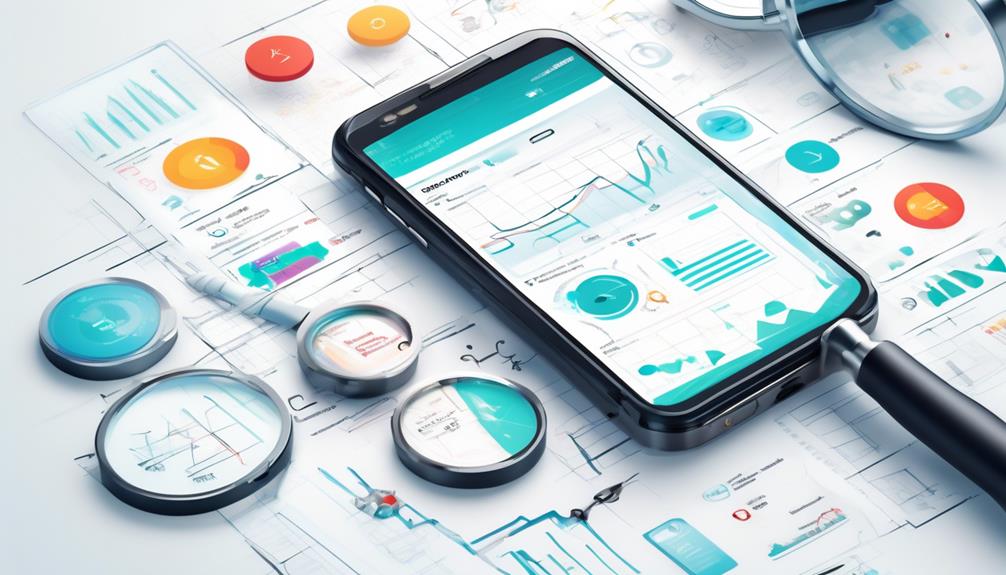To gauge software quality effectively, focus on key metrics like test automation coverage, test pass/fail rates, and defect detection speed. Track KPI indicators such as bug resolution time, test execution frequency, and stability improvements over time. Consider user experience metrics like load times, responsiveness, and usability. By monitoring these, you can assure your QA efforts lead to reliable, user-friendly products. Keep exploring to discover more ways to optimize your quality measurement approach.
Key Takeaways
- Use defect density, test pass rates, and code coverage to quantify testing effectiveness and identify quality gaps.
- Monitor test automation metrics like execution frequency and speed to ensure continuous integration success.
- Track user experience KPIs such as load times, responsiveness, and usability scores for comprehensive quality assessment.
- Measure bug detection and resolution times to evaluate responsiveness and software stability.
- Align KPIs with project goals, focusing on metrics that reflect both technical quality and user satisfaction.

Measuring software quality is essential for ensuring that a product meets user expectations and performs reliably. When you focus on the right metrics, you can identify areas needing improvement and track progress over time. Test automation plays a crucial role here, enabling you to run repeatable, efficient tests that catch issues early. Automated tests provide faster feedback, helping you reduce manual effort while increasing test coverage. By incorporating test automation into your quality metrics, you can measure the frequency of test executions, the pass/fail rates, and the speed at which bugs are detected and resolved. These indicators not only reflect the stability of your code but also how well your testing processes support continuous delivery. Additionally, tracking test coverage can help ensure that critical parts of your software are thoroughly verified, reducing the risk of undetected issues. User experience is another indispensable aspect to measure, as it directly influences user satisfaction and product success. When you evaluate user experience, you’re looking at metrics like load times, responsiveness, and usability. Tools that gather user feedback, such as surveys or heatmaps, can help quantify how intuitive your interface is and whether users find it engaging. By monitoring user behavior and complaints, you gain insights into pain points that might not be obvious through technical testing alone. Combining these insights with technical metrics gives you a comprehensive view of your software’s quality.
Frequently Asked Questions
How Do Metrics Differ Between Agile and Traditional Development?
You’ll find that metrics in Agile focus on flexibility and speed, like velocity and sprint burndown, emphasizing continuous improvement. In contrast, traditional development values stability, so metrics such as defect density and requirements coverage help guarantee thoroughness and predictability. Agile metrics adapt quickly to changes, fostering responsiveness, while traditional metrics prioritize consistency and exhaustive documentation, supporting a more controlled, steady process.
What Are the Best Tools for Tracking Software Quality KPIS?
Imagine a dashboard flashing with real-time insights—this is where the best tools shine. You’ll want platforms like Jenkins or SonarQube, which excel at tracking KPIs through automated testing and code coverage. These tools give you instant visibility into software quality, helping you catch issues early and guarantee your project stays on track. With them, you turn data into action, making your QA process more precise and effective.
How Can Teams Balance Quantitative Metrics With Qualitative Insights?
You should balance quantitative metrics with qualitative insights by actively gathering customer feedback and analyzing user experience. Use metrics to identify patterns, but also listen to users’ opinions to understand their needs and frustrations. Incorporate surveys, usability tests, and direct feedback channels to gain deeper insights. This combined approach guarantees your team makes informed decisions that improve software quality while addressing real user concerns.
What Challenges Exist in Implementing Effective Quality Metrics?
Sometimes, the path to effective quality metrics feels like steering a complex maze. You face challenges like ensuring stakeholder engagement and achieving metric standardization across teams. Resistance to change and inconsistent data collection can slow progress. To succeed, you need clear communication, buy-in from all stakeholders, and consistent standards. Overcoming these hurdles helps you create meaningful metrics that truly reflect software quality and drive continuous improvement.
How Often Should Software Quality Metrics Be Reviewed and Updated?
You should review and update software quality metrics regularly, ideally every sprint or release cycle, to support continuous improvement. This frequency guarantees stakeholders engaged and ensures your metrics stay relevant as project goals evolve. By frequently reassessing these metrics, you can identify trends, address issues promptly, and foster a culture of ongoing quality enhancement, ultimately driving better software outcomes and stakeholder satisfaction.
Conclusion
By tracking the right metrics, setting clear KPIs, and continuously analyzing your data, you can effectively measure software quality. You identify issues more quickly, improve your processes more efficiently, and deliver better products more confidently. You embrace transparency, foster accountability, and drive improvement at every stage. Ultimately, measuring software quality isn’t just about numbers; it’s about understanding, enhancing, and excelling in your QA efforts. Keep measuring, keep improving, and keep delivering excellence.









